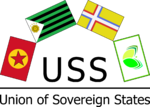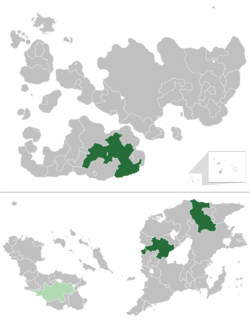Union of Sovereign States
 Logo | |
 Member states Former members | |
| Headquarters | |
| Official languages | |
| Type | IGO |
| Membership | |
| Leaders | |
• Chairman of the General Assembly | |
• Chairman of the Council of Ministers | |
• Chairman of the Security Council | |
| Establishment | 25 May 2015 |
| Area | |
• Total | 2,556,361 km2 (987,017 sq mi) |
| Population | |
• 2016 estimate | 124,561,940 |
| Currency | |
a. Secretariat. b. General Assembly. | |
The Union of Sovereign States (USS; Arabic: اتحاد الدول ذات السيادة; Jindalean: 주권국가의연합; Lettucian: Unió d'Stats Suberans; Norwegian: Unionen av Suverene Stater; Spanish: Unión de Estados Soberanos) is an international organization consisting of the Arab Republic of Gandhara, the Bolivarian Republic of Lettuce, the Democratic People's Republic of Jindalea, and the Kingdom of Kimmystan. The USS was established on 25 May 2015 to promote international cooperation between the member states.
History
The Union was formed with the signing of the "Treaty on the Creation of a Union between DPR Jindalea and Gandhara".[1] According to the Preamble of the Treaty, the official name of the Union is the Union of Sovereign States, reflecting the sovereignty of its members. The USS is an intergovernmental organization whose overarching aim is promoting comprehensive cooperation among the member states.
On 11 June 2015, Lettuce officially joined the Union.[2] RC Laranjeiras was the second country to join the Union on 1 August 2015.[3] After presidential elections in RC Laranjeiras, held on 11 September 2015, Gustavo Silveira, leader of the far-right wing party PLL (Partido Liberal Laranjeirense; English: Laranjeirian Liberal Party), was elected president.[4] The elections led to protests around the country. The protesters claimed that there has been electoral fraud and demanded new elections. After the protests, Gustavo Silveira dissolved the Parliament, and former president Victor Ramsés was banned from the country.[5] Ramsés fled to eastern Outernatia and received asylum in Lettuce. The Government of the Bolivarian Republic of Lettuce stated that they don't recognize the results of the 2015 presidential elections in RC Laranjeiras, and they sent a letter to the Secretary-General of the Union calling for the revocation of RC Laranjeiras' membership. On 13 September 2015, RC Laranjeiras unilaterally withdrew from the Union.[6] On 2 January 2016, Kimmystan officially joined the Union.[7]
Members
| Country | Capital | Accession | Population | Area (km2) |
|---|---|---|---|---|
| Sanggumdang | 25 May 2015 (founder) | 71,034,556 | 891,005 | |
| Rhea | 25 May 2015 (founder) | 32,516,229 | 674,463 | |
| Nordfjord | 2 January 2016 | 14,703,669 | 945,444 | |
| Hugo Chávez City | 11 June 2015 | 6,307,486 | 45,449 |
Institutions and legal framework
The member states retain their own sovereignty and international personality, meaning that DPR Jindalea, Gandhara, Kimmystan, and Lettuce are still fully responsible for their own internal affairs and external relations. The Union itself cannot claim representation in other international organizations or overrule legislation or government decisions of its member states.
The Treaty on the Creation of a Union between DPR Jindalea and Gandhara has established four institutions: the General Assembly, the Council of Ministers, the Security Council, and the Secretariat.
General Assembly
The General Assembly is the main deliberative assembly of the Union. The assembly meets every 6 months, but emergency sessions can also be called. The assembly is presided over by the head of state whose country holds the chairmanship, and is located in Rhea.
Council of Ministers
Composed of the member states' Prime Ministers, Ministers of Foreign Affairs, Economy, and Finance, the Council of Ministers assists the General Assembly in promoting political, cultural, and economical cooperation between the member states. The Council also discusses about mutual foreign affairs of the member states, and advises the General Assembly on matters of international relations.
Security Council
The Security Council is charged with maintaining peace and security among the member states. The Council consists of 24 members, 6 from each member state. Its powers include the authorization of military action through resolutions. Security Council resolutions will be enforced by military forces voluntarily provided by member states. As the function of the Security Council is the protection of the lives and properties of its subjects, it will only act if either signatory becomes involved in war. The governments of the member states hold veto power over resolutions.
Secretariat
All activities of the Union are coordinated and monitored by its Secretariat, which is located in Sanggumdang. The Secretary-General is the head of the Secretariat, and also acts as the de facto spokesperson and leader of the Union.
Developments
Symbols
Since the formation of the Union, there has not been official recognition of a flag or coat of arms. During official meetings, the flags of DPR Jindalea, Gandhara, Kimmystan, and Lettuce are used, which clearly depicts the sovereignty of these countries. Another reason to keep using national flags is that, although the member states have strong ties, the difference between their cultures makes it difficult to create a flag that represents all nations.
On 2 January 2016, after the accession of Kimmystan into the Union, the General Assembly adopted an official logo.
Expansion
According to the Treaty, it is possible for other countries to join the Union. The governments of the member states have to give their approval to the accession of new member states. After the approval of the member states, the accession of a new member state will be effected by a decision of the General Assembly. Lettuce was the first country to join the Union on 11 June 2015, followed by RC Laranjeiras on 1 August 2015 and Kimmystan on 2 January 2016. RC Laranjeiras unilaterally withdrew after political turmoil on 13 September 2015.
References
- ^ "Creation of the Union of Sovereign States". 25 May 2015.
- ^ "Lettuce officially joins the Union". 11 June 2015.
- ^ "RC Laranjeiras becomes a member of the Union". 1 August 2015.
- ^ "Results of the 2015 presidential elections in RC Laranjeiras". 11 September 2015.
- ^ "Ex-president Victor Ramsés banned from RC Laranjeiras". 13 September 2015.
- ^ "More changes coming to RC Laranjeiras". 13 September 2015.
- ^ "Kimmystan joins USS". 2 January 2016.